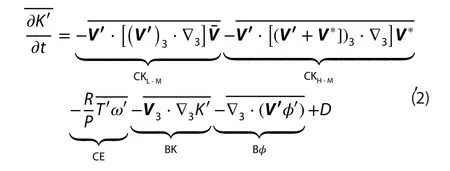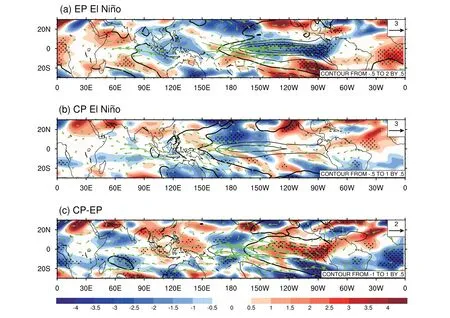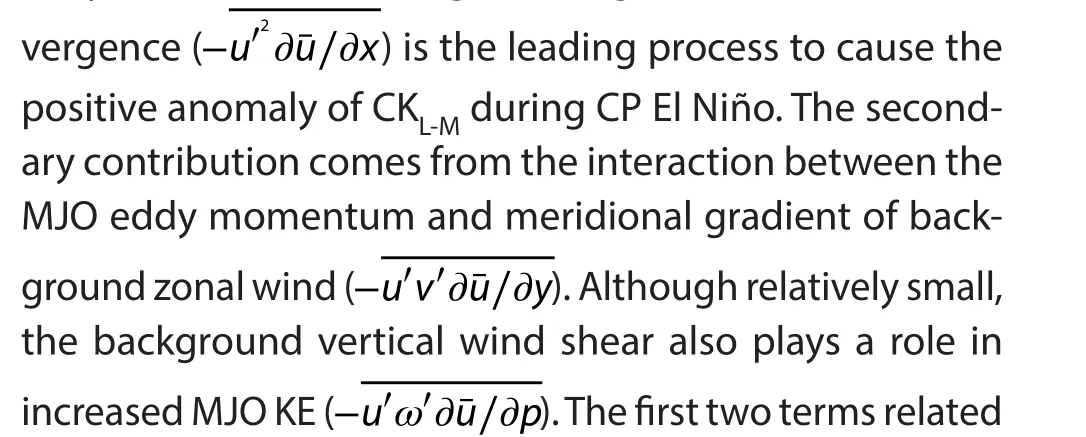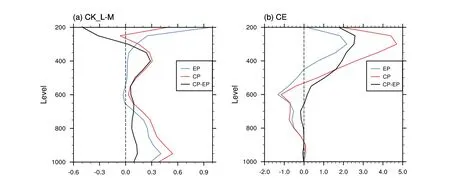Energetic processes regulating the strength of MJO circulation over the Maritime Continent during two types of El Ni?o
HSU Pang-Chi, FU Zhen an XIAO Ting
aKey Laboratory of Meteorological Disaster of Ministry of Education, Nanjing University of Information Science & Technology, Nanjing, China;
bJoint International Research Laboratory of Climate and Environment Change, Nanjing University of Information Science & Technology, Nanjing,China; cCollaborative Innovation Center on Forecast and Evaluation of Meteorological Disasters, Nanjing University of Information Science &Technology, Nanjing, China; dGuangzhou Meteorological Observatory, Guangzhou, China
1. Introduction
The MJO (Madden and Julian 1971) is the dominant mode of intraseasonal variability over the tropics. Its convection-circulation coupled signals are of a planetary scale and propagate eastward along the equator. During its journey, the MJO interacts with different weather and climate systems, such as tropical cyclones (Camargo, Wheeler,and Sobel 2009; Maloney and Dickinson 2003), extreme rainfall events (Mao, Sun, and Wu 2010; Yang 2010; Hsu,Lee, and Ha 2016), monsoon activity (Lee et al. 2013), and ENSO (Slingo et al. 1999; Kessler 2001; Hendon, Wheeler,and Zhang 2007), in fluencing the evolution and amplitude of these weather and climate systems. Advancing our understanding of MJO variation at different timescales and mean flow-MJO-eddies scale interactions can bridge the gap between weather forecasting and climate prediction(Waliser 2006), which is key to developing a seamless prediction system (Palmer et al. 2008).
The interannual variation of MJO activity is generally linked to the changes in equatorial SST at the interannual timescale. Earlier studies (Slingo et al. 1999; Kessler 2001;Hendon, Wheeler, and Zhang 2007) focused on the interaction between the MJO and conventional ENSO, which has the maximum SST warming over the eastern equatorial Pacific (referred to as eastern Pacific El Ni?o, or EP El Ni?o).Accompanied by the eastward shift of anomalous SST warming, the strengthened MJO signals tend to extend farther east toward the eastern Pacific, while weakened MJO activity appears over the western Pacific, during EP El Ni?o years (Hendon, Zhang, and Glick 1999; Kessler 2001). Since the beginning of the twenty- first century, a new type of El Ni?o with a significant SST warming over the central Pacific(referred to as CP El Ni?o) has been observed frequently.CP El Ni?o induces a different modulating effect on MJO activity compared to EP El Ni?o (Gushchina and Dewitte 2012; Feng et al. 2015; Yuan, Li, and Ling 2015; Chen, Ling,and Li 2016; Hsu and Xiao 2017). The suppressed MJO over the western Pacific and Maritime Continent during CP El Ni?o events is of less significance than that during EP El Ni?o years. Some studies have suggested that the difference in the MJO over the western Pacific/Maritime Continent could be related to the suppressed effect of the Walker circulation and the anticyclonic circulation anomaly near the Philippine Sea during different types of El Ni?o events (Feng et al. 2015; Yuan, Li, and Ling 2015; Chen,Ling, and Li 2016).
Although possible relationships between the anomalous mean flow and MJO associated with each type of El Ni?o have been indicated (Feng et al. 2015; Yuan, Li, and Ling 2015; Chen, Ling, and Li 2016), the detailed processes and relative contributions of these anomalous circulations to the changes in the MJO need to be investigated. In addition to large-scale circulations, synoptic-scale variability is also vigorous over the Maritime Continent (Chang, Harr,and Chen 2005) and may have in fluences on MJO activity through upscaled feedback. In this study, we examine the main source of increased MJO kinetic energy (KE) during CP El Ni?o events based on a newly proposed MJO KE budget equation derivation. We also quantitatively discuss how scale interactions among low-frequency background flow, the MJO, and high-frequency disturbances modulate the MJO strength during different types of El Ni?o.
2. Methodology
To identify the deep convection associated with MJO and high-frequency disturbances, we use daily OLR on a 2.5 × 2.5° grid from NOAA (Liebmann 1996). The changes in dynamic and thermodynamic conditions and their in fluences on the MJO are examined using daily-averaged fields of horizontal wind (u,v), verticalp-velocity (ω), temperature (T), and geopotential (?) from ERA-Interim (Dee et al. 2011). These fields have a resolution of 1.5 × 1.5 and 19 levels from 1000 to 100 hPa with 50-hPa intervals. All data cover the period 1979–2014.
To reduce data uncertainty, the average of monthly SST data derived from HadISST1 (Rayner et al. 2003) and ERSST.v3 (Smith et al. 2008) are used to categorize the two different types of El Ni?o. Using the method proposed by Yeh et al.(2009) and others (e.g. McPhaden, Lee, and McClurg 2011;Ren and Jin 2011), the CP and EP cases are classified based on the amplitude of SST anomalies over the Ni?o3 (5°S–5°N,90°–150°W) region and the Ni?o4 (5°S–5°N, 160°E–150°W)region. Those El Ni?o events with a larger Ni?o3 than Ni?o4(larger Ni?o4 than Ni?o3) warming during boreal winter are considered as EP El Ni?o (CP El Ni?o) events. Four EP El Ni?o events (1982/83, 1986/87, 1991/92, and 1997/98) and five CP El Ni?o events (1994/95, 2002/03, 2004/05, 2006/07,and 2009/10) are selected for the study period.
To quantitatively examine the physical processes modulating the MJO activity during the two types of El Ni?o,the MJO KE budget is derived and then diagnosed. The conventional energy budget equation is derived by partitioning the meteorological variable into two parts –background mean flow and perturbation – to diagnose the energy conversion between the two (Oort 1964; Lau and Lau 1992; Maloney and Dickinson 2003; Hsu and Chih-Hua 2009). To understand the scale interactions of MJO with both the mean flow and high-frequency disturbances, we decompose a variable into three parts in the time domain, including the low-frequency mean flow (>90 days), MJO (20–90 days), and high-frequency disturbances (< 20 days), as follows:

where the overbar denotes the low-frequency component;the prime and asterisk denote the 20–90-day MJO and the high-frequency disturbances of shorter than 20 days,respectively. Here, we apply Lanczos band-pass filtering(Duchon 1979), 90-day low-pass and 20-day high-pass filtering to extract the MJO, low-frequency mean flow and high-frequency disturbances, respectively. This derivation strategy is similar to that used in Hsu, Li, and Tson (2011)and Tsou, Hsu, and Hsu (2014), although these studies focused on the KE sources of synoptic-scale eddies rather than the MJO.
By multiplyingu′ andv′ on both sides of the MJO-filtered horizontal momentum equations, respectively,the MJO KE budget equation is obtained as


3. Results
Figures 1 and 2 show the changes in subseasonal variability (including 20–90-day MJO and high-frequency disturbances of less than 20 days), large-scale circulations, and SST patterns during the mature phase (autumn-winter)of the two types of El Ni?o events relative to their climatological conditions. When the SST warming maximizes at the eastern equatorial Pacific (Figure 1(a)), the ascending motion of the Walker circulation and trade winds are reduced significantly. A low-level divergence (Figure 1(a))associated with a downward anomaly of the Walker circulation (Figure 2(a)) can be observed over the Maritime Continent. An anticyclonic anomaly appears near the Philippine Sea (Wang, Wu, and Fu 2000). Along with the changes in background dynamic and thermodynamic conditions, both the atmospheric MJO (Figure 1(a)) and high-frequency eddies (Figure 2(a)) are weakened over the western Pacific and Maritime Continent during the EP El Ni?o events.

Figure 1. Kinetic energy of 20–90-day MJO (shading; units: m2 s?2), monthly SST (contours; units: °C), and monthly 850-hPa wind (vectors;units: m s?1) anomalies during autumn-winter (September-February) of (a) EP and (b) CP El Ni?o events relative to their climatological states. The differences in these fields between CP and EP El Ni?o events (CP minus EP) are shown in (c). Stippling marks the regions with the changes in MJO KE exceeding the 90% con fidence level.
As the warm SST anomaly shifts westward during CP El Ni?o events, the low-level divergence and anticyclonic anomalies associated with the descending anomaly of the Walker circulation are of less significance (Figures 1(b)and 2(b)), compared to those during EP El Ni?o events(Figures 1(a) and 2(a)). Thus, the differences in large-scale circulations between CP and EP El Ni?o events exhibit lowlevel convergence and cyclonic anomalies (Figure 1(c))associated with ascending anomalies over the Maritime Continent (Figure 2(c)). The amplitude of transient eddies at the intraseasonal and synoptic timescales vary obviously over the Maritime Continent during the two types of El Ni?o. The MJO has higher KE over the Maritime Continent during CP El Ni?o than during EP El Ni?o (Figure 1(b)and (c)), consistent with the findings of Chen, Ling, and Li (2016). Although the high-frequency variability tends to weaken over the Maritime Continent during both CP and EP El Ni?o events relative to the climatology (Figure 2(a) and (b)), the reduction in KE of high-frequency disturbances is less during CP El Ni?o events compared to that during EP El Ni?o events (Figure 2(c)).
The results of Figures 1 and 2 are based on the seasonal average. To ensure the timing when the two types of El Ni?o exert differential in fluences on the MJO circulation, we analyze the temporal evolution of equatorial MJO KE (not shown). The significant increase in MJO KE during CP El Ni?o appears over the Maritime Continent from mid-September of the El Ni?o developing year to the following February. This con firms our composite analysis for the period of autumn-winter (September-February) is reasonable.
To compare the amplitude and life cycle of MJO KE over the Maritime Continent between the two types of El Ni?o, enhanced MJO circulation events occurring over the region (10°S–10°N, 90°–150°E) with significant changes in MJO KE between the CP and EP El Ni?o events (Figure 1(c)) are selected and composited. An enhanced MJO circulation event is identified by the MJO KE over the key region of (10°S–10°N, 90°–150°E) exceeding one standard deviation. The date with maximum KE for each enhanced MJO event is de fined as Day 0. Figure 3(a) compares the KE evolution of composited active MJO events in CP and EP El Ni?o years. The enhanced MJO KE is obvious over the Maritime Continent during CP El Ni?o and larger than that during EP El Ni?o, in agreement with the result in Figure 1(c). From nine days before the MJO KE reaches its maximum, a positive tendency of MJO KE can be found for both CP and EP El Ni?o (not shown). The growth rate of MJO KE is larger during CP El Ni?o than during EP El Ni?o,accounting for the enhanced MJO KE over the Maritime Continent during CP El Ni?o (Figure 3(a)).

Figure 2. Kinetic energy of less than 20-day eddies (shading; units: m2 s?2) and 500-hPa monthly vertical p-velocity (contours; units:Pa s?1) of (a) EP and (b) CP El Ni?o events relative to their climatological states. The differences in these fields between CP and EP El Ni?o events (CP minus EP) are shown in (c). Stippling marks the regions with the changes in eddy KE exceeding the 90% con fidence level. The thick solid and dashed contours denote the anomalies of 500-hPa vertical p-velocity at 0.2 and ?0.2 Pa s?1, respectively.
To understand the key processes modulating the sources of MJO KE associated with the two types of El Ni?o,the column (1000–200 hPa) MJO KE budget (Equation (2))is diagnosed during Day ?9 to 0 (Figure 3(b)). The larger growth rate of MJO KE during CP El Ni?o is mainly from the barotropic energy conversion from mean flow to MJO (CKL-M) and the baroclinic energy conversion from the MJO available potential energy to KE (CE). The positive contribution of CKL-Mvia scale interaction between anomalous mean flow and MJO appears in the mid-to-lower troposphere(Figure 4(a)). However, the CE associated with the MJO circulation-convection coupled feedback plays an important role in maintaining the increased MJO KE during CP El Ni?o at the upper troposphere (Figure 4(b)). Although the MJO obtains more KE during CP El Ni?o, it provides more KE to high-frequency eddies through CKH-M(Figure 3(b)) in the meantime, supporting the enhanced high-frequency variability over the Maritime Continent (Figure 2(c)). The redistributions of MJO KE associated with the advection process and geopotential flux contribute negatively to the increased MJO KE during CP El Ni?o (Figure 3(b)).

Figure 3 (a) Differences in composited MJO kinetic energy (blue curve; units: m2 s?2) and its tendency (red curve; 10?6 m2 s?3) over the Maritime Continent (10°S?10°N, 90°?150°E) between CP and EP El Ni?o events. Day 0 represents the date when the MJO kinetic energy reaches its maximum for each event. (b) MJO kinetic energy budget terms integrated between 1000 and 200 hPa over the Maritime Continent during Day ?9 to 0 for EP (blue bars) and CP (red bars) El Ni?o events and their differences (black bars). Units: kg s?3. (c) As in(b) except for individual terms of CKL-M.

The individual terms of CKL-Mare then compared to identify the major contributors (Figure 3(c)). The MJO eddy momentum working on background zonal flow conto zonal wind convergence and cyclonic anomalies show a large contribution at the lower troposphere, while the third term associated with vertical wind shear maximizes around 400 hPa where the zonal wind changes its sign(not shown). During CP El Ni?o, the descending anomaly of the Walker circulation and low-level divergence anomaly over the Maritime Continent are weaker compared to those during EP El Ni?o (Figure 2(a) and (b)). Meanwhile,the Philippine Sea anticyclonic anomaly tends to be weakened during CP El Ni?o (Figure 1(c)), similar to the findings of Yuan, Yang, and Zhang (2012). These large-scale anomalies associated with the westward shift of the equatorial SST warming pattern (i.e. CP El Ni?o) generate enhanced barotropic energy conversion from the mean flow to MJO KE as they work with MJO eddy momentum fluxes.

Figure 4. Vertical pro files of (a) CKL-M and (b) CE over the Maritime Continent (10°S–10°N, 90°–150°E) averaged over the period of Day?9 to 0, when the MJO kinetic energy shows positive tendency in Figure 3, for MJO cases during CP El Ni?o (red curve), EP El Ni?o (blue curve), and their differences (black curve). Units: 10?5 m2 s?3.
4. Summary
The distinct impacts of CP and EP El Ni?o events on western Pacific MJO activity have been documented previously(Gushchina and Dewitte 2012; Feng et al. 2015; Yuan, Li,and Ling 2015; Chen, Ling, and Li 2016; Hsu and Xiao 2017).However, the physical mechanisms responsible for the differences in MJO associated with the two types of El Ni?o have not been fully understood. Particularly, the western Pacific/Maritime Continent is the region that undergoes vigorous multi-scale variability. How and to what extent the changes in background mean flow and high-frequency disturbances in fluence the MJO during the CP and EP El Ni?o need further elucidation.
In this study, we derive a new MJO KE budget equation, in which the low-frequency background mean flow-MJO interaction and high-frequency disturbances-MJO interaction are formulated, to quantitatively examine the physical processes modulating the MJO activity during different El Ni?o events. The results show that both the barotropic energy conversion from background mean flow to MJO KE (CKL-M) and baroclinic energy conversion from MJO available potential energy to KE (CE) contribute positively to the enhanced MJO KE over the Maritime Continent during the mature phase of CP El Ni?o. Among the three-dimensional large-scale circulation anomalies during CP El Ni?o, the low-level convergence and cyclonic anomalies related to a weakened descending branch (or an upward anomaly) of the Walker circulation over the Maritime Continent and the reduced Philippine anticyclonic anomaly play crucial roles in favoring the KE conversion from mean flow to MJO. Different from the positive contribution of CKL-Moccurring at the mid-to-lower troposphere, the enhanced CE is the major contributor to the strengthened MJO KE at the upper troposphere during CP El Ni?o. Based on the diagnosis of interaction between MJO and high-frequency disturbances (CKH-M), we find that the high-frequency variability over the Maritime Continent is enhanced during CP El Ni?o because it obtains more KE from the MJO.
Understanding the multi-scale interaction is a key step for developing seamless prediction (Waliser 2006; Palmer et al. 2008), while the quantitative diagnosis of scale interactions is still challenging. The new MJO KE budget equation proposed in this study can help to diagnose how and to what extent the MJO interacts with the mean flow and with the high-frequency disturbances. The energy source of the MJO is also examined quantitatively using the MJO KE budget equation. Specifically, we use this diagnostic approach to explain the modulation of the MJO by different types of El Ni?o. We plan to carry out more studies related to MJO dynamics and scale interactions based on the diagnosis of the MJO KE budget equation.
Acknowledgments
The authors would like to thank the anonymous reviewers for their help in improving the manuscript.
Disclosure statement
No potential conflict of interest was reported by the authors.
Funding
This study was supported by the National Natural Science Foundation of China [grant number 41375100]; the National Basic Research Program of China [973 Program, grant number 2015CB453200]; and the Natural Science Foundation of Jiangsu Province [grant number BK20140046].
References
Camargo, S. J., M. C. Wheeler, and A. H. Sobel. 2009. “Diagnosis of the MJO modulation of tropical cyclogenesis using an empirical index.”Journal of the Atmospheric Sciences66 (10):3061–3074.
Chang, C.-P., P. A. Harr, and H. J. Chen. 2005. “Synoptic disturbances over the equatorial South China Sea and western Maritime Continent during boreal winter.”Monthly Weather Review133 (3): 489–503.
Chen, X., J. Ling, and C. Y. Li. 2016. “Evolution of the Madden–Julian oscillation in two types of El Ni?o.”Journal of Climate29 (5): 1919–1934.
Dee, D. P., S. M. Uppala, A. J. Simmons, P. Berrisford, P. Poli, S.Kobayashi, U. Andrae, et al. 2011. “The ERA-Interim reanalysis:con figuration and performance of the data assimilation system.”Quarterly Journal of the Royal Meteorological Society137 (656): 553–597.
Duchon, C. E. 1979. “Lanczos filtering in one and two dimensions.”Journal of Applied Meteorology18 (8): 1016–1022.
Feng, J., P. Liu, W. Chen, and X. C. Wang. 2015. “Contrasting Madden–Julian Oscillation activity during various stages of EP and CP El Ni?os.”Atmospheric Science Letters16 (1): 32–37.
Gushchina, D., and B. Dewitte. 2012. “Intraseasonal tropical atmospheric variability associated with the two flavors of El Ni?o.”Monthly Weather Review140 (11): 3669–3681.
Hendon, H. H., C. Zhang, and J. D. Glick. 1999. “Interannual variation of the Madden–Julian oscillation during austral summer.”Journal of Climate12 (8): 2538–2550.
Hendon, H. H., M. C. Wheeler, and C. Zhang. 2007. “Seasonal dependence of the MJO–ENSO relationship.”Journal of Climate20: 531–543.
Hsu, P.-C., and C.-H. Tsou, 2009. “Eddy energy along the tropical storm track in association with ENSO.”Journal of the Meteorological Society of JapanSer. II 87(4): 687–704.
Hsu, P.-C., and T. Xiao. 2017. “Differences in the initiation and development of the Madden–Julian Oscillation over the Indian Ocean associated with two types of El Ni?o.”Journal of Climate30 (4): 1397–1415.
Hsu, P. C., T. Li, and C. H. Tsou. 2011. “Interactions between Boreal Summer Intraseasonal Oscillations and Synoptic-Scale Disturbances over the Western North Pacific. Part I: Energetics Diagnosis*.”Journal of Climate24 (3): 927–941.
Hsu, P.-C., J.-Y. Lee, and K.-J. Ha. 2016. “In fluence of boreal summer intraseasonal oscillation on rainfall extremes in southern China.”International Journal of Climatology36 (3):1403–1412.
Kessler, W. S. 2001. “EOF representations of the Madden–Julian oscillation and its connection with ENSO.”Journal of Climate14 (13): 3055–3061.
Lau, K.-H., and N.-C. Lau. 1992. “The energetics and propagation dynamics of tropical summertime synoptic-scale disturbances.”Monthly Weather Review120 (11): 2523–2539.
Lee, J.-Y., B. Wang, M. C. Wheeler, X. H. Fu, E. Duane, and W.-S.Kang. 2013. “Real-time multivariate indices for the boreal summer intraseasonal oscillation over the Asian summer monsoon region.”Climate Dynamics40 (1-2): 493–509.
Liebmann, B., and C. A. Smith 1996. “Description of a complete(interpolated) outgoing longwave radiation dataset.”Bulletin of the American Meteorological Society77: 1275–1277.
Madden, R. A., and P. R. Julian. 1971. “Detection of a 40–50 day oscillation in the zonal wind in the tropical Pacific.”Journal of the Atmospheric Sciences28 (5): 702–708.
Maloney, E. D., and M. J. Dickinson. 2003. “The intraseasonal oscillation and the energetics of summertime tropical western North Pacific synoptic-scale disturbances.”Journal of the Atmospheric Sciences60 (17): 2153–2168.
Mao, J. Y., Z. Sun, and G. X. Wu. 2010. “20–50-day oscillation of summer Yangtze rainfall in response to intraseasonal variations in the subtropical high over the western North Pacific and South China Sea.”Climate Dynamics34 (5): 747–761.
McPhaden, M. J., T. Lee, and D. McClurg. 2011. “El Ni?o and its relationship to changing background conditions in the tropical Pacific Ocean.”Geophysical Research Letters38 (15):L15790.
Oort, A. H. 1964. “On estimates of the atmospheric energy cycle.”Monthly Weather Review92 (11): 483–493.
Palmer, T. N., F. J. Doblas-Reyes, A. Weisheimer, and M. J. Rodwell.2008. “Toward seamless prediction: Calibration of climate change projections using seasonal forecasts.”Bulletin of the American Meteorological Society89 (4): 459–470.
Rayner, N. A., D. E. Parker, E. B. Horton, C. K. Folland, L. V.Alexander, P. Rowell, C. Kent, and A. Kaplan. 2003. “Global analyses of sea surface temperature, sea ice, and night marine air temperature since the late nineteenth century.”Journal of Geophysical Research: Atmospheres108 (D14): 4407.doi: 10.1029/2002JD002670.
Ren, H.-L., and F.-F. Jin. 2011. “Ni?o indices for two types of ENSO.”Geophysical Research Letters38 (4): L04704.
Slingo, J. M., D. P. Rowe, R. Sperber, and F. Nortley. 1999. “On the predictability of the interannual behaviour of the Madden-Julian Oscillation and its relationship with El Ni?o.”Quarterly Journal of the Royal Meteorological Society125 (554): 583–609.
Smith, T. M., R. W. Reynolds, T. C. Peterson, and J. Lawrimore.2008. “Improvements to NOAA’s Historical Merged Land–ocean Surface Temperature Analysis (1880–2006).”Journal of Climate21: 2283–2296.
Tsou, C.-H., H.-H. Hsu, and P.-C. Hsu. 2014. “The role of multiscale interaction in synoptic-scale eddy kinetic energy over the western North Pacific in autumn.”Journal of Climate27 (10):3750–3766.
Waliser, D. E. 2006. “Intraseasonal variability.”The Asian Monsoon.Springer Berlin Heidelberg, 203–257.
Wang, B., R. Wu, and X. Fu. 2000. “Pacific–East Asian teleconnection: How does ENSO affect East Asian climate?”Journal of Climate13 (9): 1517–1536.
Yang, J. 2010. “Biweekly and 21–30-day variations of the subtropical summer monsoon rainfall over the lower reach of the Yangtze River basin.”Journal of Climate23 (5): 1146–1159.
Yeh, S.-W., J.-S. Kug, B. Dewitte, M.-H. Kwon, B. P. Kirtman, and F.-F. Jin. 2009. “El Ni?o in a changing climate.”Nature461 (7263):511–514.
Yuan, Y., S. Yang, and Z. Zhang. 2012. “Different evolutions of the Philippine Sea anticyclone between the eastern and central Pacific El Ni?o: Possible effects of Indian Ocean SST.”Journal of Climate25 (22): 7867–7883.
Yuan, Y., C. Y. Li, and J. Ling. 2015. “Different MJO activities between EP El Ni?o and CP El Ni?o.”Scientia Sinica Terrae45: 318–334.
 Atmospheric and Oceanic Science Letters2018年2期
Atmospheric and Oceanic Science Letters2018年2期
- Atmospheric and Oceanic Science Letters的其它文章
- On assessing haze attribution and control measures in China
- Preface
- Assessing satellite-derived net surface radiative flux in the Arctic
- Revisiting the intraseasonal, interannual and interdecadal variability of tropical cyclones in the western North Pacific
- Regional earth system modeling: review and future directions
- When and how will the Millennium Silk Road witness 1.5 °C and 2 °C warmer worlds?
